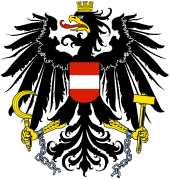2015 Styrian state election
The Styrian state election of 2015 was held in the Austrian state of Styria on 31 May 2015.
| This article is part of a series on the |
| Politics of Austria |
|---|
 |
|
|
|
|
|
|
|
This is not the most recently election to determine the composition of the state legislature, which is called Landtag in German, rather than parliament.
Styrians went to the polls again on Sunday, 24 November 2019. This was a snap election. The push for early dissolution of the current Landtag came from the FPÖ, but the eventual vote on the issue was supported by three parties, including the Greens.[1]
Based on preliminary data, the results are as follows, in order of success: ÖVP 36% SPÖ 23% FPÖ 18% Greens 12% KPÖ 6% and Neos 5%.[2]
As was the case at the federal level in the September 2019 parliamentary election, the skandal-ridden FPÖ was the biggest loser, compared to its strong showing in the previous elections in 2015 (see data below). The People's Party achieved a resounding victory at the expense of both the FPÖ and the Social Democrats, whose leader took responsibility for the loss of more than 6 percentage points, and promptly resigned.[3]
The Green Party exceeded 10% for the first time in the history of Landtag elections in Styria.[4] The Greens did particularly well in Graz, where they were head-to-head with the ÖVP, with the final outcome of the contest unknown until all postal and out-of-precinct ballots were counted.[5]
Both the Communist Party and the NEOS will be represented in the provincial legislature, based on their respective shares of the vote in the 5-6% range. Entry into the Landtag will be a first for the NEOS in Styria.
The Austrian People's Party (ÖVP), which had historically been the dominant party in Austria's fourth-largest state by population, will have a choice in seeking a coalition partner in the state government. The election outcome in Styria is somewhat similar to the current political constellation of power in Vienna, where coalition talks are under way between the ÖVP and the Greens to form the next government at the federal level.[6] For the Greens to be part of a government, however, the support of a third party, such as the NEOS, would be required to assure majority support in the Landtag.
Austria generally uses proportional representation to convert votes for political parties (technically, lists, for purposes of elections) into seats in its legislative bodies, but there is no 4% threshold in election for the state legislature in Styria. Parties must instead win at least one basic mandate (Grundmandat) in one of four regional electoral districts by collecting a minimum number of votes (Wahlzahl) that varies because it is calculated by taking into account all valid votes cast (which is a function of turnout, not just the number of registered voters) and the number of mandates available in a given district (Wahlkreis). A party that achieves at least one basic mandate in any one district may then aggregate its remaining votes statewide and receive additional mandates (Restmandate) based on its proportionate share in the second stage of the process by which votes are translated into seats following an election.
The total number of mandates is 48. They are apportioned to the four regional districts based on the latest population census.[7] As elsewhere in Austria, the voting age is 16.[8] Turnout was low by historical standards.[9] It used to be much higher under compulsory voting.
According to early projections at the end of election day (the polls closed early), the distribution of seats in the Landtag was going to be as follows: ÖVP 18, SPÖ 11, FPÖ 8, die Grüne 6, die KPÖ 3 Neos 2. (APA, 24.11.2019).[10] The projection turned out to be inaccurate, however. Based on the final count that includes ballots cast by voters outside their home precincts using voting cards (Wahlkarten), one of the three seats projected for the Communists went to the Social Democrats instead.[11] These voting cards are not voter ID cards, but are issued upon request for specific elections to allow voters to vote at a polling station other than the one in their home precinct. Voters can also vote by mail. To cast their ballot at their local polling station, voters only need to show their passport or ID card because their name and address will be on the precinct list of registered voters. They are checked off when they receive their paper ballot and proceed to the voting booth to mark it in secrecy and then drop it in the ballot box.
2015 Styrian Election Results
| Party | Votes in % | Change | Seats | |
| Social Democratic Party of Austria (SPÖ) | 29.29% | -8.97% | 15 | |
| Austrian People's Party (ÖVP) | 28.45% | -8.74% | 14 | |
| Freedom Party of Austria (FPÖ) | 26.76% | +16.10% | 14 | |
| The Greens – The Green Alternative (GRÜNE) | 6.68% | +1.13% | 3 | |
| Communist Party of Austria (KPÖ) | 4.22% | -0.19% | 2 | |
| Team Stronach (FRANK) | 1.74% | — | 0 | |
| Pirate Party of Austria (PIRAT) only in election district 1 | 0.22% | — | 0 | |
| NEOS – The New Austria (NEOS) | 2.64% | — | 0 |
References
- Um 17:23, 05 09 2019. "Steirer wählen Landtag am 24. November". Die Presse (in German). Retrieved 2019-11-24.CS1 maint: numeric names: authors list (link)
- "Wahlen". egov.stmk.gv.at. Retrieved 2019-11-24.
- Rombold, Von Wilfried; Uhr, Günter Pilch | 22 24; November 2019, 25 (2019-11-25). "Der Tag nach der Wahl zum Nachlesen: Schickhofers Rücktritt: Leichtfried übernimmt SPÖ, Lang will folgen". www.kleinezeitung.at (in German). Retrieved 2019-11-26.CS1 maint: numeric names: authors list (link)
- Dunst, Von Ulrich; Zottler, Markus; Uhr, Manfred Neuper | 18 54; November 2019, 24 (2019-11-24). "Der Wahltag im Liveticker: ÖVP legt massiv zu, SPÖ klar im Minus, FPÖ stürzt ab". www.kleinezeitung.at (in German). Retrieved 2019-11-24.CS1 maint: numeric names: authors list (link)
- red, ORF at/Agenturen (2019-11-25). "Steiermark-Wahl: ÖVP bleibt in Graz vor Grünen". news.ORF.at (in German). Retrieved 2019-11-26.
- daniela.kittner. "Rückenwind für eine Kurz-Kogler-Koalition". kurier.at (in German). Retrieved 2019-11-24.
- Leeb, Verwaltung-Land Steiermark, Michaela. "LTW - Wahlkreiseinteilung, Anzahl der Mandate". www.verwaltung.steiermark.at (in German). Retrieved 2019-11-24.
- Leeb, Verwaltung-Land Steiermark, Michaela. "LTW - aktives Wahlrecht". www.verwaltung.steiermark.at (in German). Retrieved 2019-11-24.
- "Steiermark-Wahl: Niedrigste Wahlbeteiligung aller Zeiten". vienna.at. Retrieved 2019-11-26.
- "ÖVP gewinnt steirische Landtagswahl, SPÖ und FPÖ verlieren massiv, Grüne erstmals zweistellig - derStandard.at". DER STANDARD (in German). Retrieved 2019-11-24.
- Das Land Steiermark [Federal Province of Styria Official Website]. "Landtagswahl 2019 - vorläufiges Ergebnis (inkl. Wahlkarten)" (PDF). Retrieved 29 November 2019.

